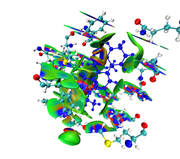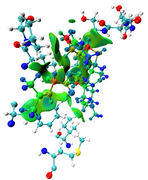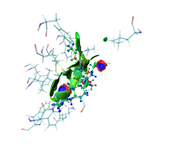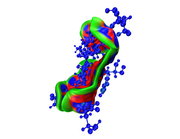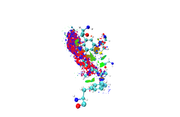Multiwfn forum
Multiwfn official website: http://sobereva.com/multiwfn. Multiwfn forum in Chinese: http://bbs.keinsci.com/wfn
You are not logged in.
- Topics: Active | Unanswered
Pages: 1
#1 Re: Multiwfn and wavefunction analysis » Error: The promolecular density for the element with index of 113 has » 2025-10-19 08:02:45
Kindly, check your email
#2 Re: Multiwfn and wavefunction analysis » Error: The promolecular density for the element with index of 113 has » 2025-10-13 12:55:35
as you see in the last image there are some isosurfaces appeared within the amino acid residues, even though, I put 'Input index of the atoms to define a fragment, e.g. 2,3,7-10' around that for Ligand only.
Kindly, check and comment
#3 Re: Multiwfn and wavefunction analysis » Error: The promolecular density for the element with index of 113 has » 2025-10-13 12:52:08
Dear Lu
What is the reason for;
1- I finished mIGM analysis and trying to get the (Evaluate contribution of atomic pairs and atoms to inter-fragment interaction (atomic and atomic pair delta-g indices as well as IBSIW index))
2- Unfortunately, I couldn't get the same colors deep green for good interactions and blue is for atoms away from interaction.
I did the same as you mentioned;
First, plot color-filled isosurfaces using the IGM_inter.vmd script as mentioned earlier. After that, we need to remove the default representation showing molecular structure, so we enter "Graphics" - "Representation", choose the first term (its current style is CPK), click "Delete Rep" button. Then we drag the previously generated atmdg.pdb into VMD main window to load it. In this file the “occupancy” field records intermolecular interactions, to graphically exhibit its value for every atom, we should let VMD color the atoms according to their occupancy property. We enter "Graphics" - "Representation" again, set "Drawing method" to CPK, and set "Coloring method" to “Occupancy”,
then click "Trajectory" tab, set upper limit of color scale to 50 and press ENTER button, now the system in graphical window should look like below.
Note
Atomic pair delta-g indices and percentage contributions (zero terms are not shown)
5 351 : 19.556075 ( 2.50 % )
3 351 : 17.894879 ( 2.29 % )
193 350 : 16.489099 ( 2.11 % )
178 350 : 15.737952 ( 2.01 % )
12 350 : 14.503133 ( 1.85 % )
#4 Re: Multiwfn and wavefunction analysis » Error: The promolecular density for the element with index of 113 has » 2025-10-12 17:25:10
Thanks, Dear Lu
I will check email.
Thanks
#5 Re: Multiwfn and wavefunction analysis » Error: The promolecular density for the element with index of 113 has » 2025-10-12 13:42:15
#6 Re: Multiwfn and wavefunction analysis » Error: The promolecular density for the element with index of 113 has » 2025-10-12 09:19:06
Dear Dr. Lu
Thanks for your reply, How can i send you the file?, send me your email address.
Kindly. send me copy of the recent two articles for mIGM and amIGM. my email address is; melhenawy111@gmail.com
Regards
#7 Re: Multiwfn and wavefunction analysis » Error: The promolecular density for the element with index of 113 has » 2025-10-11 07:56:04
Dear Lian
Here you can find the result of mine, as I understand from reading-out the manual regarding mIGM.
1- From the cluster analysis result I got the selected amino acid residues near the ligand and then save the file in .xyz containing one frame only and upload it to Multiwfn, then follow the steps of mIGM.
The results contain: 1) blue color for strong interactions like H-bond. 2) Green color for the noncovalent interactions like Van der Waals. 3) Red color for allosteric.
Is this result correct and my conclusion right?
Thanks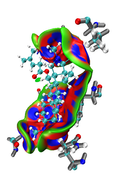
#8 Re: Multiwfn and wavefunction analysis » Error: The promolecular density for the element with index of 113 has » 2025-10-11 03:33:13
Dear Lian
As you mentioned that NCI is out-of-date and the best is
amIGM is the best method for characterizing dynamically averaged weak interactions. okay
if i will study for a single compound, should I use NCI or mIGM
Thanks, here you are my email address
melhenawy111@gmail.com
#9 Re: Multiwfn and wavefunction analysis » Error: The promolecular density for the element with index of 113 has » 2025-10-10 08:27:28
Dear Lian
One important thing, after I got the selected coordinates for a ligand and the surrounding amino acids in .xyz file for about 1000 frames usinf the following (same residue as within 3.5 of resname LIG or (not protein and not waters and not ions and not ion)) in VMD, when I used to open .xyz file with notepad++, I got that there are some water molecules and one Ion, so I remove all water molecules and ions from the .xyz file.
So the .xyz file will have only atomic coordinates for amino acids and ligand
Is this, okay? or I should not remove the water molecules?
Kindly, reply for this matter.
Thanks
#10 Re: Multiwfn and wavefunction analysis » Error: The promolecular density for the element with index of 113 has » 2025-10-10 07:22:08
Dear Tian
Can you share me the above-mentioned manuscripts
Tian Lu, Graphically Revealing Weak Interactions in Dynamic Environments Using amIGM Method, Struct. Bond. (2025) https://doi.org/10.1007/430_2025_95
Tian Lu, Visualization Analysis of Covalent and Noncovalent Interactions in Real Space, Angew. Chem. Int. Ed., 137, e202504895 (2025) DOI: 10.1002/anie.202504895
As i don't have access to get it both.
#11 Re: Multiwfn and wavefunction analysis » Error: The promolecular density for the element with index of 113 has » 2025-10-09 15:31:19
Dear Dr. Tian Lu
I am greatly appreciating your reply, I would like to inform you that I have succeeded to get the run work. I will attach you the result picture since I got so many red color around my ligand, keeping in mind that I used VMD to choose residues around my ligand within 3.5 A and remove all water molecules and others protein residues and also ions, and grid spacing was 0.13 bohr.
how can I solve this?
By the way, do you think that analyzing IGM (Independent Gradient Model) may get better information than aNCI?
Thanks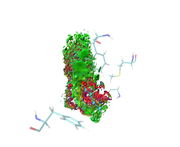
#12 Re: Multiwfn and wavefunction analysis » Error: The promolecular density for the element with index of 113 has » 2025-10-06 09:08:15
I mean in my last reply that the .pdb file contains atoms of the Ligand and surrounding amino acids within 3.5 A and some H2O molecules.
the total number is 320 atoms. however, in the .pdb file these atoms repeated more and more for several repeated times.
#13 Re: Multiwfn and wavefunction analysis » Error: The promolecular density for the element with index of 113 has » 2025-10-06 09:05:42
I have already added a .pdb file with the same name as .xzy
So, as you mentioned, I have to record correct element names in that .pdb file. so to change CA into carbon 'only'
Note, the .pdb file it too large
Am i right?
#14 Multiwfn and wavefunction analysis » Error: The promolecular density for the element with index of 113 has » 2025-10-06 04:22:00
- melhenawy111
- Replies: 22
Dear aal
When I was trying to get aNCI for my simulation (filename.xyz) I got an error message 'Error: The promolecular density for the element with index of 113 has not been supported yet!'
I followed the steps as mentioned in the article "Using Multiwfn to perform aNCI analysis to graphically study protein-ligand interactions in dynamic process" http://sobereva.com/591
In details:
20
3
1,1001
11
72-130 (atomic number of the LIG 'the number of the first and last atoms of the LIG as in the .pdb file' Note, I got the .pdb file just after I saved the .xyz file)
4.5
0.17
Coordinate of origin in X,Y,Z is 47.309292 -47.095754 -21.081785 Bohr
Coordinate of end point in X,Y,Z is 79.269292 -15.645754 12.068215 Bohr
Grid spacing in X,Y,Z is 0.170000 0.170000 0.170000 Bohr
Number of points in X,Y,Z is 189 186 196 Total: 6890184
Calculating averaged density, gradient and Hessian of density
Error: The promolecular density for the element with index of 113 has not been supported yet!
Error: The promolecular density for the element with index of 113 has not been supported yet!
Error: The promolecular density for the element with index of 113 has not been supported yet!
Error: The promolecular density for the element with index of 113 has not been supported yet!
As you see the Error comes out.
Kindly, try to help me to solve this.
Regards
Pages: 1
